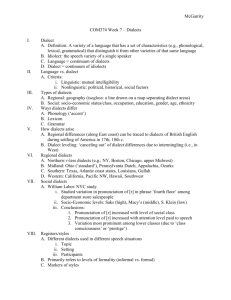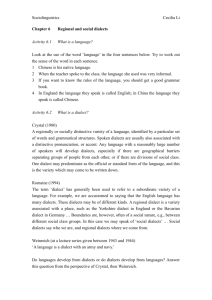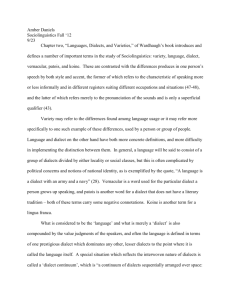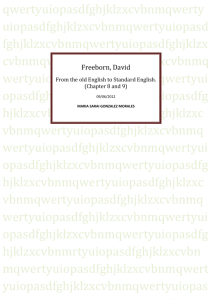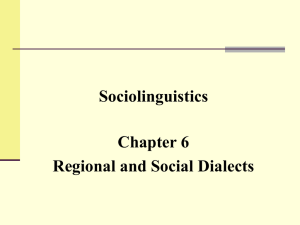Contact-Induced Morphological Change in the Agul Dialects.
advertisement
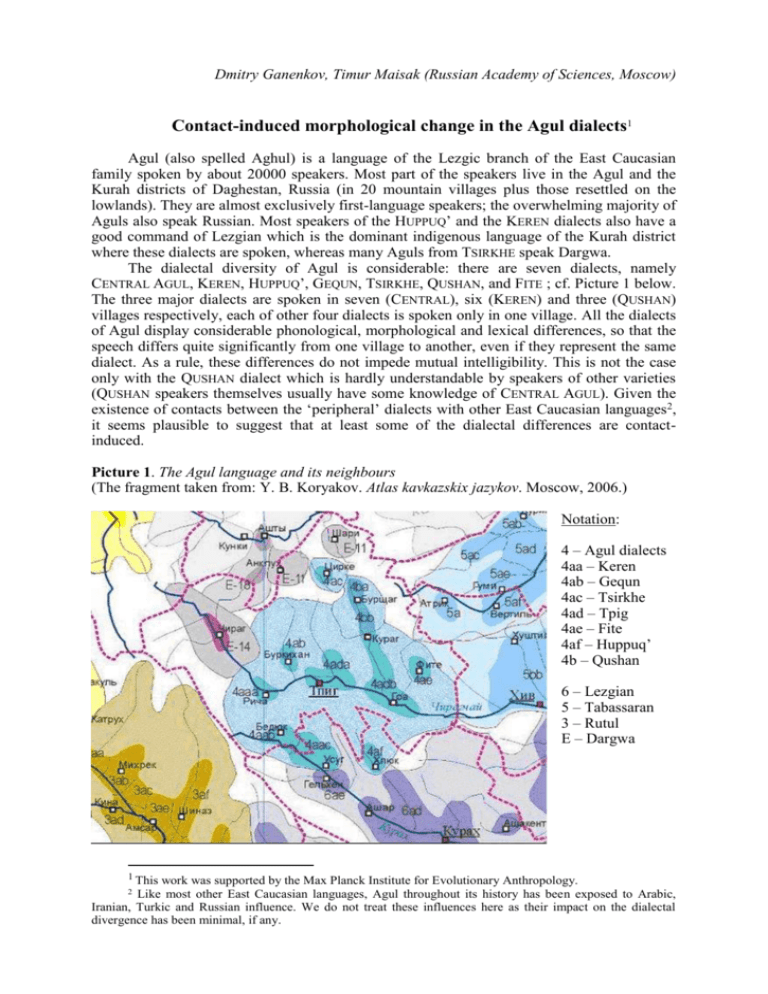
Dmitry Ganenkov, Timur Maisak (Russian Academy of Sciences, Moscow) Contact-induced morphological change in the Agul dialects1 Agul (also spelled Aghul) is a language of the Lezgic branch of the East Caucasian family spoken by about 20000 speakers. Most part of the speakers live in the Agul and the Kurah districts of Daghestan, Russia (in 20 mountain villages plus those resettled on the lowlands). They are almost exclusively first-language speakers; the overwhelming majority of Aguls also speak Russian. Most speakers of the HUPPUQ’ and the KEREN dialects also have a good command of Lezgian which is the dominant indigenous language of the Kurah district where these dialects are spoken, whereas many Aguls from TSIRKHE speak Dargwa. The dialectal diversity of Agul is considerable: there are seven dialects, namely CENTRAL AGUL, KEREN, HUPPUQ’, GEQUN, TSIRKHE, QUSHAN, and FITE ; cf. Picture 1 below. The three major dialects are spoken in seven (CENTRAL), six (KEREN) and three (QUSHAN) villages respectively, each of other four dialects is spoken only in one village. All the dialects of Agul display considerable phonological, morphological and lexical differences, so that the speech differs quite significantly from one village to another, even if they represent the same dialect. As a rule, these differences do not impede mutual intelligibility. This is not the case only with the QUSHAN dialect which is hardly understandable by speakers of other varieties (QUSHAN speakers themselves usually have some knowledge of CENTRAL AGUL). Given the existence of contacts between the ‘peripheral’ dialects with other East Caucasian languages2, it seems plausible to suggest that at least some of the dialectal differences are contactinduced. Picture 1. The Agul language and its neighbours (The fragment taken from: Y. B. Koryakov. Atlas kavkazskix jazykov. Moscow, 2006.) Notation: 4 – Agul dialects 4aa – Keren 4ab – Gequn 4ac – Tsirkhe 4ad – Tpig 4ae – Fite 4af – Huppuq’ 4b – Qushan 6 – Lezgian 5 – Tabassaran 3 – Rutul E – Dargwa 1 This work was supported by the Max Planck Institute for Evolutionary Anthropology. Like most other East Caucasian languages, Agul throughout its history has been exposed to Arabic, Iranian, Turkic and Russian influence. We do not treat these influences here as their impact on the dialectal divergence has been minimal, if any. 2 In the present paper we confine ourselves to morphological differences between the dialects, the most important of which are listed in Table 1 below. The TPIG column shows the typical CENTRAL AGUL isoglosses (the village of Tpig is the administrative centre of the Agul district). The KEREN and the HUPPUQ’ dialects spoken in the southern part of Agul-speaking area have been in tight contact with Lezgians for at least several centuries. On the contrary, the TSIRKHE dialect is spoken in the northern extreme of the Agul-speaking area on the border with the Dargwa-speaking area. QUSHAN is the most peculiar Agul dialect, which is not far from Dargwa and Tabassaran villages, although intensive contacts between them are not attested. It is not always easy to distinguish a contact-induced morphological change from a change arising due to the independent development of a certain dialect. It should be noted that the contact can help both to preserve a particular proto-language isogloss (which can be lost in other dialects) as well as to innovate some phenomenon which has never existed in the proto-language. These two cases are also difficult to distinguish between. The situation with the Agul dialects is also complicated because two of the contact languages, namely Lezgian and Tabassaran, are closely related to Agul – these three languages form the East Lezgian group. However, discussing particular morphological changes we will give evidence that seem to support (or, on the contrary, refute) their contact-induced nature. A clear example of a morphological feature that has appeared due to contact is the noun plural marker -jar in the HUPPUQ’ and the KEREN dialects. The suffix -jar is used here to mark plural with nouns ending in a vowel, whereas all other dialects employ the original plural marker -wur || -bur || -wr (cf. gada-jar vs. gada-bur ‘boys’). The new suffix have been definitely borrowed from Lezgian, since in all Lezgian dialects this is the only plural marker with nouns ending in a vowel. A clear example of the Dargwa influence is the vocative proclitic wa in TSIRKHE, which has ousted the proclitic ja used in all other dialects (cf. wa baw vs. ja baw ‘hey, mother!’). A contact-induced loss of a morphological distinction can be exemplified by the merger of two localization markers in the HUPPUQ’ and the KEREN dialects – the ‘Sub’ localization in -k: marking location under a landmark, and the ‘Cont’ localization in -k marking location of a part on/in the whole (like handle on cupboard or salt in soup) and fixed attachment (like picture on wall). In all the other dialects the two locative forms are opposed, cf. cilik ‘on/under the wall’ (HUPPUQ’) vs. calikː ‘under the wall’ ~ calik ‘on the wall’ (TPIG). The loss of the distinction between -k and -kː is obviously due to the contact with Lezgian where the same merger happened due to phonological reasons. An interesting grammatical feature that might have been retained due to the Lezgian influence is the productive repetitive/reversive marking by means of prefix q- in the HUPPUQ’ and the KEREN dialects, cf. ag˳as ‘see’ > q-ag˳as ‘see again’, χas ‘bring’ > qu-χas ‘bring back’, ic’as ‘give’ > qa-jc’as ‘give back’, etc. The repetitive affix q- || qi- is quite productive in Lezgian, which can be the source for this morpheme in HUPPUQ’ and KEREN. However, the same repetitive marker is also attested in some other Lezgic languages like Rutul and Tsakhur, so it is most likely that this is the old repetitive morpheme inherited from ProtoLezgic, which has been lost in the bulk of the Agul dialects and in Tabassaran. Finally, we can point out a distinction that is not contact-induced but rather reflects the independent diachronic ‘drift’ of the dialects. In the majority of Agul dialects the question marker on verb is -wa, cf. aq’une-wa? ‘did (he) do it?’ from CENTRAL AGUL. Only in the QUSHAN dialect the marker is -n || -in, like in Tabassaran; note that Lezgian also has the question marker -ni. We may deal here with the Common East Lezgic question clitic *-ni, while -wa in Agul is a later innovation. In this case we do not need to appeal to the contact to explain the preservation of -n || -in in QUSHAN. This morpheme may go back to the Early Agul stage before the separation of the QUSHAN branch from the ‘core’ Agul community (which later broke up into several dialects), and before the rise of the new question particle -wa in the latter3. Table 1. Main morphological differences between the dialects of Agul TPIG HUPPUQ’ KEREN TSIRKHE (Central (South (South (North Agul) periphery) periphery) periphery) NOUN MORPHOLOGY plural marker -bur -jar -jar -wr (after vowels) ‘Sub’ vs. different same same different ‘Cont’ localizations ‘In-Lative’ -di absent absent -ʔ locative form ‘Prolative’ absent absent absent present locative form vocative ja ja ja wa proclitic PERSONAL PRONOUNS Nominative coincide coincide differ coincide vs. Ergative ADJECTIVES nominalizer -f -f -f -f (Nom.Sg) NUMERALS counting decimal vigesimal vigesimal decimal system VERBAL MORPHOLOGY copula e e e, i i conditional -či(n) -či(n) -či(n) -šin marker question -wa -wa -wa -wa marker plural in the absent absent absent -aj, -raj Imperative repetitive absent q-, qa-, quq-, qa-, quabsent prefix negative infixal prefixal infixal infixal morpheme sonorant stem retained (in lost lost retained augments most idioms) QUSHAN (North-East periphery) -wur different -di absent ja coincide -d, -r decimal wu -t’en -n, -in -raj absent infixal retained 3 Another evidence of the proto-Agul nature of the -n question marker may be its use with negative verbal forms in the Tsirhe dialect, in rhetorical questions like aʁajdawa-n zu was ‘I tell you, don’t I?’ (literally ‘don’ttell I to-you?’).



